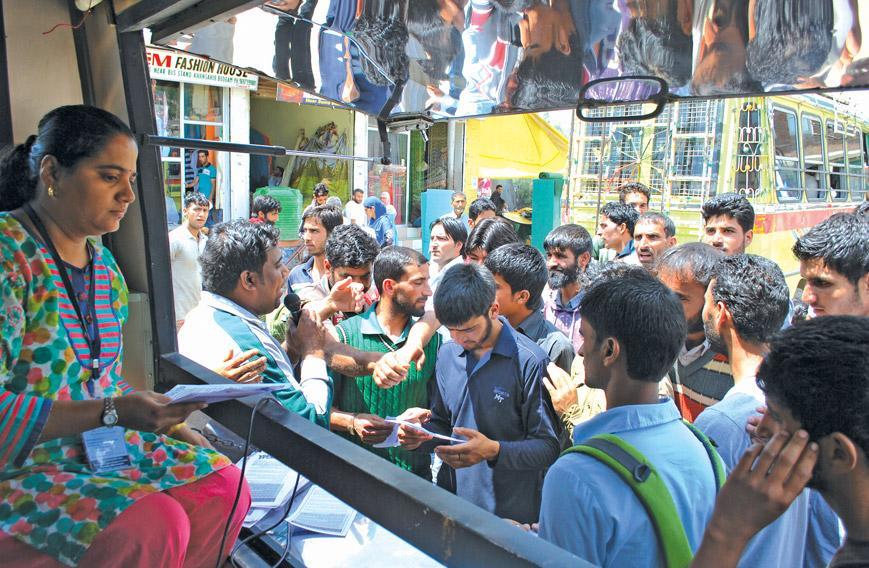
Poor RTI access in J&K
Jehangir Rashid, Srinagar
Jammu and Kashmir was one of the few states to introduce the Right to Information (RTI) Act for bringing transparency in government functioning. However, 13 years after its introduction, most public authorities are wanting in implementation of the Act.
A study by advocates Bilal Ahmad Bhat and Syed Iram Quadri reveals that the public authorities are not complying adequately with Section 4 (1) (b) of the Jammu & Kashmir Right to Information Act.
Under this section they are supposed to proactively reveal information about the functioning of departments. This includes detailed organisational information such as listing of the functions, powers and duties of their officials.
The public should also be informed about the rules, regulations, norms and manuals that must guide the work of officials. Other disclosures include details of decision-making processes, budgets and expenditure, subsidiary programmes, permissions issued and a list of all records held in paper or electronic form.
The websites of the administration are meant to provide such information but don’t with the exception of Kargil. The websites aren’t user friendly and links don’t open. They are also in English, which is alien to most ordinary people in Kashmir.
“The administration in both Jammu and Kashmir divisions of the state has dedicated official websites. Both websites have an RTI link displayed on the homepage. However, they do not contain all the information mandated to be displayed under Section 4 (1) (b) of the J&K RTI Act,” says the study.
The survey was conducted as part of the internship programme hosted by the Commonwealth Human Rights Initiative (CHRI) in New Delhi during February 1 to 28. Both Bhat and Quadri are members of the Jammu & Kashmir Right to Information Movement and the School for Rural Development and Environment.
Under the programme, the two lawyers compiled basic data regarding compliance with proactive information disclosure requirements after surveying the websites included in the study. John Mascrinaus of CHRI cross-checked the data. Venkatesh Nayak, Programme Coordinator, CHRI, was also part of the study.
“The website of the Divisional Commissioner, Kashmir and Ladakh, displays only the text of J&K RTI Act and the 2012 RTI Rules under the RTI link. It also connects to the Jammu & Kashmir State Information Commission (SIC) website. However, details of Public Information Officers and First Appellate Authorities are not available at this link or under the links Contact Us and Key Officers. Similarly, the Section 4 (1) (b) Manual Handbook is also not displayed on the website,” says the study.
The website of the Divisional Commissioner, Jammu, fares much worse in terms of compliance with Section 4 (1) (b) of the J&K RTI Act. The ‘RTI’ link does not open on any internet browser. As a result, it is not possible to access Section 4 (1) disclosures or the list of PIOs and FAAs.
“More than half, that is, 59 percent of the districts (13 of 22) have not uploaded Section 4 (1) (b) information to a reasonable degree of compliance on their official websites. In several cases Section 4 (1) (b) information has simply not been drawn up and displayed on the websites or where they have been drawn up they are often incomplete,” the study says.
Three-fourths of the district websites do not display any information about their annual budgets. Only the district administrations of Bandipora and Budgam have displayed the latest budget information for 2016-17. While the Budgam district website displays Section 4 (1) (b) information in a limited manner, the Bandipora website does not display either Section 4 (1) (b) information or details of PIOs and FAAs.
“The Kargil district website is by far the best website among all the districts surveyed in Jammu & Kashmir. It contains Section 4 (1) (b) information not only in relation to the Deputy Commissioner’s office, but also about 42 departments and other public authorities that have operations in the district,” reads the study.
All the other districts that have complied with the requirements of Section 4 (1) (b) have displayed information only in relation to a small sub-set of the 16 categories of information that must be proactively disclosed.
All information on the websites of Divisional Commissioners of Jammu and Kashmir is in English without any accompanying Urdu version, making it inaccessible to the large segments of people in J&K who are not familiar with English.
“There are several good practices in Jammu & Kashmir regarding proactive disclosure of information. However, these practices need to be codified and issued in the form of comprehensive guidelines for improving the compliance of the public authorities at different levels of the state government with the proactive disclosure requirements under the J&K RTI Act,” suggests the study. The study also suggests that the General Administration Department should examine the detailed implementation guidelines issued by the Department of Personnel and Training, Government of India, since 2011 for adoption at the Secretariat, district, tehsil and halqa panchayat levels of the administration and develop assistance programmes in consultation with civil society actors, universities and the Institute of Management and Public Administration for ensuring implementation.



